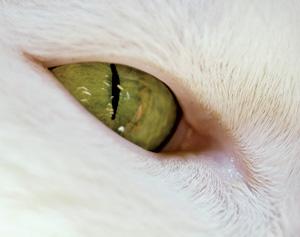猫的眼外肌控制瞳孔收缩过程无须大脑发出神经信号驱动,虹膜上一种对视觉敏感的黑素蛋白可以完成这一过程 。

通常认为哺乳动物是靠眼睛和大脑之间的信号来调整瞳孔的大小以及控制投射到视网膜上的光量。King-Wai Yau及其约翰-霍普金斯大学的同事发现从动物身上取出的眼球在晚上、黄昏、黎明的时候还能保持活跃——包括猫、狗、仓鼠,能够继续对光线做出反应。他们追踪到瞳孔中一种对光敏感的黑素蛋白的影响。老鼠的眼睛组织里缺少表达这种黑素蛋白的基因,同样的条件小鼠不能对光做出反应。
这种黑素蛋白在鸟类、鱼类和两栖类也有相似的功能。参与这项研究的牛津大学Stuart Peirson认为,这有可能为夜行性的哺乳动物提供一种工具,避免它们突然暴露在光线下眼睛发花。
这项研究也可以运用到人类临床医学上,有一些失明是由于对视网膜上视觉敏感的视杆细胞或视锥细胞的缺失而造成。Peirson说,有可能利用黑素蛋白让瞳孔的其他细胞也对视觉敏感。(生物探索译)
相关英文论文摘要:
Melanopsin signalling in mammalian iris and retina
Non-mammalian vertebrates have an intrinsically photosensitive iris and thus a local pupillary light reflex (PLR). In contrast, it is thought that the PLR in mammals generally requires neuronal circuitry connecting the eye and the brain. Here we report that an intrinsic component of the PLR is in fact widespread in nocturnal and crepuscular mammals. In mouse, this intrinsic PLR requires the visual pigment melanopsin; it also requires PLCβ4, a vertebrate homologue of the Drosophila NorpA phospholipase C which mediates rhabdomeric phototransduction. The Plcb4−/− genotype, in addition to removing the intrinsic PLR, also essentially eliminates the intrinsic light response of the M1 subtype of melanopsin-expressing, intrinsically photosensitive retinal ganglion cells (M1-ipRGCs), which are by far the most photosensitive ipRGC subtype and also have the largest response to light. Ablating in mouse the expression of both TRPC6 and TRPC7, members of the TRP channel superfamily, also essentially eliminated the M1-ipRGC light response but the intrinsic PLR was not affected. Thus, melanopsin signalling exists in both iris and retina, involving a PLCβ4-mediated pathway that nonetheless diverges in the two locations.
英文论文链接:https://www.nature.com/nature/journal/v479/n7371/full/nature10567.html







